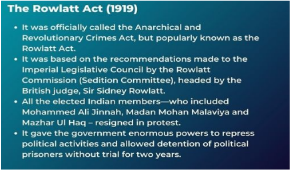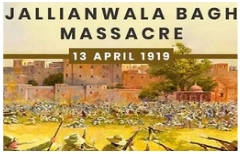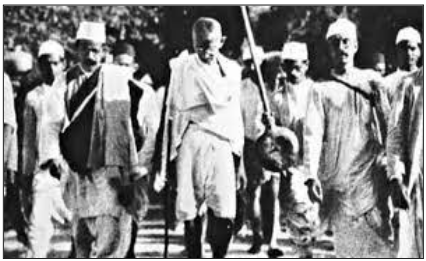Introduction
The Non-Cooperation Movement (NCM) marked the first nationwide protest led by Mahatma Gandhi in 1920 during the British colonial rule in India.
It arose as a strong and passionate reaction to a combination of grievances and disappointments that had been accumulating among the Indian population. The immediate triggers for the movement were the oppressive Rowlatt Act and the brutal Jallianwala Bagh Massacre.
During a special session of the Congress in Calcutta in September 1920, the Non-Cooperation Movement was approved, and it received further endorsement at the Nagpur session in December 1920. The movement garnered extensive participation from people across the country. However, Gandhi decided to call off the movement on February 11, 1922, following the Chauri Chaura incident in the Gorakhpur district of Uttar Pradesh. This incident involved violence against police officers by protestors, prompting Gandhi to reassess the non-violent principles of the movement and suspend it to prevent further bloodshed.
Launch of the Movement:
Following the enactment of the Rowlatt Act, the Jallianwala Bagh massacre, and the Khilafat Movement, Mahatma Gandhi declared his plan to initiate the Non-Cooperation Movement against the British Government. In a special session held in Calcutta in September 1920, the Congress approved the Non-Cooperation Movement, aiming for its continuation until the issues in Punjab and Khilafat were addressed, and self-rule (Swaraj) was achieved. This program of non-cooperation received unanimous support in the December 1920 Nagpur session of the Indian National Congress (INC).
Causes of the Non-Cooperation Movement
The Non-Cooperation Movement had various causes, including the aftermath of the First World War, the Rowlatt Act, the Jallianwala Bagh Massacre, and the Montagu-Chelmsford Reforms.
- Simmering Dissent: The British colonial rulers had already impoverished the Indian masses through economic exploitation. During and after the First World War, the economic and political situation worsened due to high inflation, heavy taxation, and the forced cultivation of cash crops.
- First World War Impact: The British government reneged on promises made during the First World War to consider nationalist demands in exchange for Indian support. This shattered the political optimism that had prevailed during the War.
- Montagu-Chelmsford Reforms: The Government of India Act 1919, introduced through the Montagu-Chelmsford reforms, fell short of Indian aspirations for self-governance and responsible government. The majority of leaders found it disappointing and unsatisfactory.
- Rowlatt Act: Enacted in 1919, the Rowlatt Act allowed the arrest and detention of Indians without trial, aiming to imprison nationalists without a chance to defend themselves. This angered nationalists, and Gandhi chose Satyagraha as a means to oppose it.

- Jallianwala Bagh Massacre: The brutal incident in Amritsar, where British troops fired on a peaceful gathering of Indians in Jallianwala Bagh, resulting in hundreds of deaths, deeply shocked and enraged the Indian population.

- Khilafat Movement: The Khilafat Movement, initiated by Indian Muslims, protested the dismantling of the Ottoman Caliphate by the British after the First World War. Gandhi supported the Khilafat cause and advocated for non-cooperation as a response.
Features of the Movement:
The Non-Cooperation Movement had various features that unfolded in different stages:
- Renunciation of Titles and Honorary Positions: People voluntarily gave up titles and honorary positions.
- Resignation from Local Bodies: Citizens resigned from memberships in local bodies as a form of protest.
- Boycott of Foreign Goods: The movement encouraged the boycott of foreign goods, including those involved in elections under the 1919 Act, courts, government functions, legal practice, and schools and colleges run by the government.
- Persuasive Campaigns and Swadeshi Adoption: Volunteers visited homes, urging people to embrace Swadeshi (locally made) goods. Foreign-made clothing was collected and burned.
- Legislative Council Boycott: There was a debate over whether to boycott legislative councils, leading to differences of opinion among participants.
- Boycott of Liquor and Toddy Shops: A movement to abstain from patronizing liquor and toddy shops was initiated.
- Establishment of National Institutions: National schools, colleges, and private panchayat courts were set up. Institutions like Kashi Vidyapeeth, Bihar Vidyapeeth, and Jamia Millia Islamia were established.
- Promotion of Swadeshi Goods and Khadi: The movement aimed to popularize Swadeshi goods and Khadi (handspun cloth).
- Hindu-Muslim Unity and Nonviolence: Emphasis was placed on maintaining unity between Hindus and Muslims and practicing strict nonviolence.
- Promotion of Charkha, Khadi, and Jail Bharo Andolan: Congress volunteers actively promoted the use of the spinning wheel (Charkha), Khadi, and participated in the "Jail Bharo Andolan" (filling jails in protest).
- Tilak Swaraj Fund: Gandhi announced the Tilak Swaraj Fund, intending to collect Rs 1 crore to support constructive work during the movement.
Spread of the Movement:
The call for non-cooperation and boycott during the Non-Cooperation Movement triggered significant responses across India, leading to widespread protests against British rule. However, the nature of the movement varied in different regions, influenced by local conditions.
- Bengal: Birendranath Sasmal organized anti-union board protests in the Contai and Tamluk sub-divisions of Midnapore.
- Assam: J.M. Sengupta led strikes in tea plantations, steamer services, and Assam-Bengal Railways.
- United Province: Baba Ram Chandra's leadership sparked agrarian riots in Rae Bareli, Pratapgarh, Fyzabad, and Sultanpur. The 'Eka movement' led by Madari Pasi expressed peasant discontent.
- Awadh: The Kisan Sabha movement gained prominence, reflecting peasant grievances.
- Punjab: The Akali movement for Gurudwara reform and control demonstrated communal unity among Sikhs, Muslims, and Hindus.
- Rajasthan: Peasants protested against cesses and begar. The Bijolia Movement in Mewar and the Bhil Movement under Motilal Tejawat were significant against British and Jagir exploitation.
- Gujarat: Vallabh Patel played a crucial role in spreading the movement, viewing non-cooperation as a viable alternative to revolutionary terrorism against colonial rule.
- Karnataka: The Non-Cooperation Movement had a limited impact in Karnataka, with the initial reaction from upper and middle-class professionals in some areas of the Madras presidency being limited. Workers at the Buckingham and Carnatic textile mills went on strike, receiving moral support from local non-cooperation leaders.
- Andhra: Tribal and peasant grievances against forest laws in Andhra were linked to the Non-Cooperation Movement. Peasants refused to pay taxes to zamindars, and the population of Chirala-Perala refused to pay taxes and vacated the town. Alluri Sitaram Raju organized tribals, aligning their demands with the Non-Cooperation Movement.
- Tamil Nadu: Leaders like C. Rajagopalachari, S. Satyamurthy, and Periyar E.V.R. led the movement.
- Kerala: Peasants organized anti-Jemni struggles, and the Mopillah revolt was intense during this period.
Causes of its withdrawal:
The Non-Cooperation Movement was a significant force in India's struggle for freedom, but Mahatma Gandhi decided to end it for various reasons:
- Chauri-Chaura Incident: In Chauri-Chaura, Uttar Pradesh, protestors attacked a police station, leading to the death of several police officers. Gandhi believed this act of violence contradicted the principle of non-violence, prompting him to halt the movement in February 1922.
- Lack of Discipline and Violence: Gandhi realized that the Indian masses were not fully ready for a nationwide civil disobedience and non-cooperation struggle. Instances of indiscipline and violence, like the violent turn of the Mopillah revolt in Kerala, made him reconsider the movement.
- Abolishment of Caliphate: The Khilafat issue, a key aspect of the non-cooperation movement, lost its relevance when the Turks, led by Mustafa Kemal, abolished the Ottoman sultanate in 1922 and the Khalifa's office in 1924.
- Rise of Militancy: Towards the later stages, there was a shift towards more radical and militant approaches. This caused a loss of popular support and alienation of certain sections of society.
- Issue of Class Revolution: The movement started taking the shape of a no-rent movement against the Zamindars. However, Gandhi intended for a "controlled mass movement" involving various Indian classes rather than a class revolution. He opposed continuing a movement that might lead to a class revolution.
- Government Repression: The British colonial government responded to the Non-Cooperation Movement with harsh measures. Volunteer corps were declared illegal, public meetings were forbidden, the press was silenced, and many Congress leaders were arrested. The government's unyielding stance and lack of willingness to negotiate also influenced Gandhi's decision to withdraw the movement.
Significance of the Non-Cooperation Movement:
The Non-Cooperation Movement, despite its abrupt end, had a profound impact on India's quest for freedom. Its significance is evident in various aspects:
- Hindu-Muslim Unity: Mahatma Gandhi believed that achieving self-rule depended on resolving the "Mohammedan question." The movement fostered an unparalleled unity between Hindus and Muslims, leading to widespread mass mobilization against colonial rule. This unity laid the groundwork for Gandhi's central role in promoting secularism.
- Social Justice: The Non-Cooperation Movement brought issues of caste discrimination and untouchability into national politics, making Gandhi a prominent leader for social justice.
- Mass Participation: Both the Khilafat and Non-Cooperation Movement saw extensive involvement from people across society, including peasants, workers, students, teachers, women, and professionals. The movement provided an outlet for the long-standing grievances of the working masses against both the British and Indian authorities. Gandhi's emphasis on non-violence also drew a large number of women into the freedom struggle, making it a true mass mobilization.
- National Consciousness: One of the most significant successes of the movement was the creation of political and social consciousness and a sense of nationalism among Indians.
- Inspiration for Subsequent Movements: The success and impact of the Non-Cooperation Movement served as inspiration for subsequent movements like the Civil Disobedience Movement and the Quit India Movement. The spirit of non-cooperation and the desire for self-rule continued to influence and guide later phases of the independence struggle.
Limitations of the Movement:
The Non-Cooperation Movement marked a significant phase in India's struggle for freedom, but it faced several limitations and challenges:
- Merger of Khilafat Issue: The Khilafat movement, initially focused on religious concerns, merged with the Non-Cooperation Movement. However, this alignment proved less beneficial for long-term secular politics in India.
- Limited Reach: Despite gaining considerable support, especially in urban areas, the Non-Cooperation Movement did not enjoy universal backing across the entire country. Many people in rural areas were not well-informed about these movements and often remained disconnected.
- Lack of Clear Goal: The movements lacked a well-defined plan beyond non-cooperation with the British for achieving independence or addressing broader socio-economic issues. This lack of clarity in goals limited the effectiveness of the movements.
- Differences: There were disagreements in strategies, ideologies, and priorities among leaders, leading to fragmentation and weakening the overall impact of the movements. For instance, there were varying opinions on the boycott of legislative councils, with leaders like C.R. Das opposing its inclusion.
Conclusion:
While the Non-Cooperation Movement represented a crucial chapter in India's struggle for independence, it faced inherent limitations. The merger with the Khilafat issue, limited outreach, a lack of clear goals beyond non-cooperation, and internal differences among leaders posed challenges to its effectiveness. Despite these constraints, the movement played a vital role in fostering national consciousness, Hindu-Muslim unity, and social justice. Moreover, it served as an inspiration for subsequent movements, highlighting the resilience and determination of the Indian people in their pursuit of freedom. The lessons learned from the Non-Cooperation Movement contributed to the evolving strategies and tactics employed in the later phases of the independence struggle.

